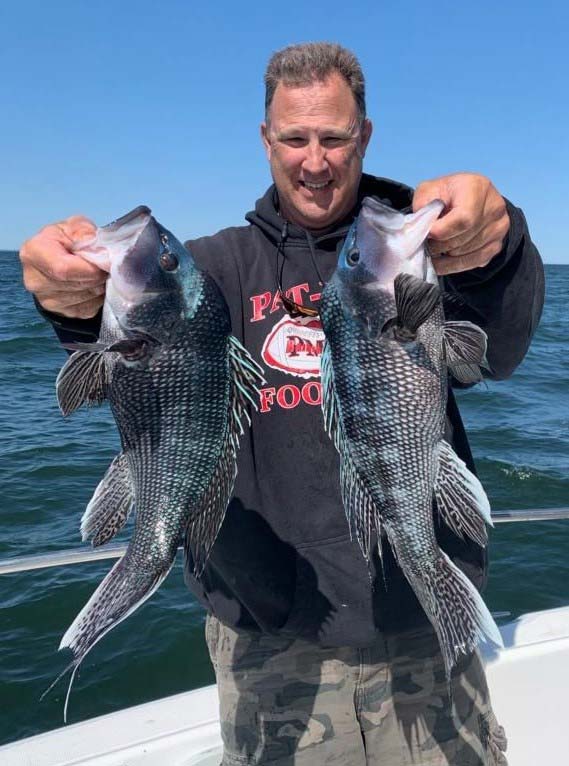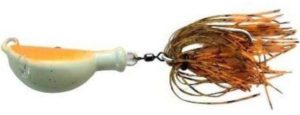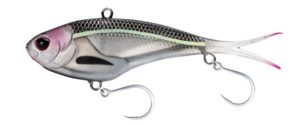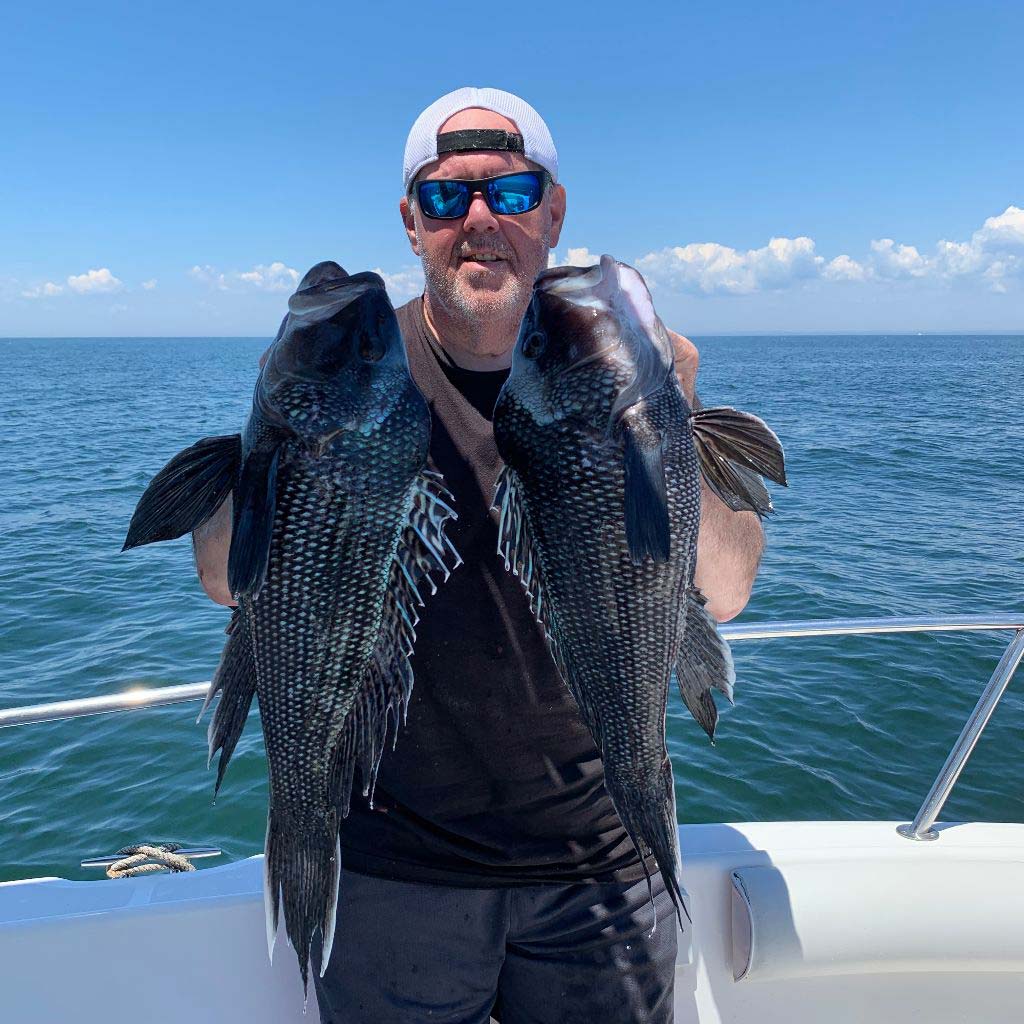
Where and how to target black sea bass when the season opens.
For the past ten seasons, the black sea bass fishery continues to hold firm in the waters surrounding Long Island as well as all of the Northeast and the Mid-Atlantic states. New Yorkers, however, continue to suffer the jabs from NOAA with their plan of implementing stringent and unfair regulations, such as challenging size limits, flimsy creel possession, and a late start to an early showing of jumbo sea bass. Open and charter boat captains, particularly from the East End of Long Island all share the same frustration, complaining of the countless giant sea bass being released by their patrons targeting fluke and porgies. This phenomenon occurs each spring since black sea bass take refuge inshore, along the rocky shallow depths of the Long Island Sound. As the calendar turns to the summer months, water temperatures rise and the indigo beauties immerse and spread out along the deeper, cooler depths. As this occurs, many do-it-yourself skippers find the search for giant sea bass in the Sound challenging regardless of the species abundance that awaits. Should that be the case, fret not, as the search for jumbos can be made simple with the proper planning and tactics that will have you icing down a limit of mighty biscuits all summer long and a resurgence again in November.
All Season Long
Starting in May, the 25- to 30-foot depths along the rocky lairs of the Long Island Sound become abundant, with medium to jumbo sea bass looking to drop their eggs for their annual spring spawn. By the time sea bass season debuts in New York waters, the fish have spread out in the 40 to 50-foot depths and continue to move as the temperatures increase. Optimistically, when you find some rockpiles in the water depth where the sea bass have settled, you can usually count on some wild fishing. During July and August, the 70 to 90-foot depths are most productive. Always keep an open mind and never become skeptical about poking around. The 70-foot depths may be producing well for me one day, and two or three days later, with a slight rise in water temperature, I often find the fish may move into the 80 to-90-foot depths. As the old saying goes, what a difference a day makes. Therefore live by those words.
Monster sea bass will seek a comfortable refuge for any period of days, then decide to be on the move the next. Of course, if you are fishing a specific spot like a wreck or a reef, you can usually count on some activity. However, unless a choice spot has been lightly fished or a piece you can call your own, most charted wrecks and reefs in the Long Island Sound will produce shorts or smallish-sized keepers due to heavy pressure, leading to disappointing results. I strongly suggest examining a quality navigational map or GPS chart for spots marked off as rocky and motor along in these areas until you hit paydirt. These are where the Jurassic Parks of the Sound live. Be sure to MOB mark (Man Overboard) them and save them for future reference.
See You In November
Okay, since the Feds took away our shot at bagging big sea bass in the shallow depths during the spring run, good things happen to those anglers with a bit of patience as early through mid-November sees a resurgence of medium to jumbo sea bass returning to the same area that they did their spawning on, which is generally in 25 to 40 feet of water. The good news here is that anglers can put more jumbos in the box just in time for the holiday season. This fishing is short-lived as the biscuits are on their way out and gulping down sea snails and sea slugs towards Block Island. Most anglers are focused on blackfish during November. However, if you bag a limit of tasty togs early in the day, a limit of sea bass from the same general area is an excellent way to finish off the day.
A Broad Choice Of Options
| A SEA BASS ARSENAL |
A number jig mentioned in this article have been proven effective for targeting sea bass. Some are more complex than others. It’s wise to have a have a nice selection on hand if you decide to go the artificial route for the biscuits.
  
|
Undoubtedly fishing hi-lo rigs, sinkers and natural bait such as fresh skimmer clams or squid strips will catch jumbo sea bass but standard bottom rigs have a much better chance of snagging into the rocks than working a single artificial jig. Indeed, sea bass are not finicky when viciously attacking a variety of natural and artificial offerings. Some proven artificial lures include the Butterfly “Flat-Side” Jigs, which have been innovatively designed to perform the best action in the most common situation of angle-vertical jigging from a drifting boat. The rear/center weight balance design lets the Jig fall to the bottom quickly with a swinging motion. The off-set eyeball position allows for using two different hooks for an overall better hooking ratio. The Tsunami’s Facet Jig is another sea bass favorite as a high visibility jig that can be danced off the bottom for strike-triggering action. Glowing tentacles in the silicone skirt provide a tempting target for wary fish in rocky structure. The Facet Jig has light-catching 3-D eyes for a realistic look and scaled holographic finish (except on the glow jig), beautifying these gems. The Facet Jigs naturally tend to circle as they are lifted in jigging. This allows them to move laterally and vertically to cover a bit more water. Swivel-rigged ultra-sharp VMC Siwash hooks complete the jig and are available in 3-1/2 and 6 ounces in Glow, Green and Silver. Another newer jigging option is the Nomad Vertrex Max. This lure can be worked like any other jig but unique to it, the Vertrex throws off a soft vibration when jigged, attracting sea bass to it.
As for diamond jigs, you can’t go wrong with the Marathon Jigs. The Marathon Diamond Jig is of sleek aqua-dynamic design with durable triple chrome plating, which leaves a long-lasting bright silver finish and are also available in a holographic finish design. Top-quality Mustad hooks round out the jigs and are available between 2 to 8 ounces. If you want some shake, rattle and roll included in your arsenal, then you absolutely can’t be without the Raging Rattler from S&S Bucktails. The Raging Rattler has a full glow head and skirt with an internal rattle. Curiosity catches the ear of the sea bass and draws them in. Also off the S&S line are the Octopi and the Flutter Jigs, which are must-haves if you take jigging sea bass and fluke seriously.
Work Those Jigs
When fishing jigs over scattered rocks, mussel, clam or oyster beds, it would be best to jig along the bottom with a foot lift and a steady bounce. Otherwise, where hard structure is involved, you just want to let the jig touch bottom, then put a couple of turns on the reel’s handle, glide, and jig just high enough above any structure you may be going over, including giant boulders. If jigging is new to you, it will take a little getting used to the difference between bites and banging against the rocks. And as for being off the bottom and out of range of the feeding calvary, fret not as sea bass have excellent eyesight and will venture well off the bottom for something of interest, particularly the jumbo bass and will hit the bait as hard as a freight train, just like their cousins, the grouper. You’ve been forewarned to hold on tight to that rod.
Proper Rigging For Jigging
I think you’ll agree that baitcasting and conventional outfits in the 20-pound class are best suited for the task. You’ll appreciate a combo light enough not to cause fatigue from jigging all day yet strong enough to manage the brutality of those jumbo knuckleheads. Although many anglers feel comfortable exercising the use of spinning tackle, I think that the rod’s leverage and the reel’s position make it awkward for proper vertical jigging. It’s just my opinion. The bottom line is you must be comfortable with your choice of tackle. Whichever you prefer will not mean you’ll catch more or less, but rather how well you work those jigs. What is relevant is employing an 8-foot shock leader, preferably fluorocarbon of 20-pound test tied to the mainline, which should be your favorite brand of braided synthetic via an Albright or Blood Knot. The reliable Improved Double Clinch Knot should be tied to your lure of choice that will round out the terminal end.

Drifting Is Key
When fishing over a wreck or a reef, especially along the South Shore or even across the Long Island Sound, anchoring is, for the most part, paramount. However, when drifting over the forgiving rocky patches and the strewn bottom infested with blue mussels that makes up parts of the Sound, drifting will be the most effective and productive approach when searching out large sea bass. The proper procedure is to motor along areas with strong potential among small rockpiles. Set your drifts accordingly well up current of the rockpile you intend to drift over. Allow plenty of time for your crew to set in position and start your jigging maneuvers until you locate a batch of sea bass. Once the action drops off, return for another drift. If you strike out after a couple of passes, make certain that you went over the designated rockpile before moving on to the next area with strong potential. Continue the procedure until you hopefully strike gold.
Watch The Weather
Although Long Island Sound can be as flat as a lake, it can also become quite lumpy, resulting in a tight chop that can make for wet and uncomfortable motoring and drifting. Since some of the hot spots are a six or seven-mile hike from most harbor entrances, getting to and from your home port can become quite a challenge. Therefore, check out marine weather reports for sea conditions and wind velocity. Keep in mind that winds from both the north and east will produce tight chop against hard moving currents, whereas a southwest breeze should make for calmer seas, providing you remain on the New York side of the Sound. Otherwise, the entire process is reversed.
This season should be another banner year for jumbo sea bass in the Long Island Sound. Therefore get out and pick away at your share of the bounty. Remember to practice self-restraint when it comes to limits to keep this fine fishery healthy and strong for years to come.





